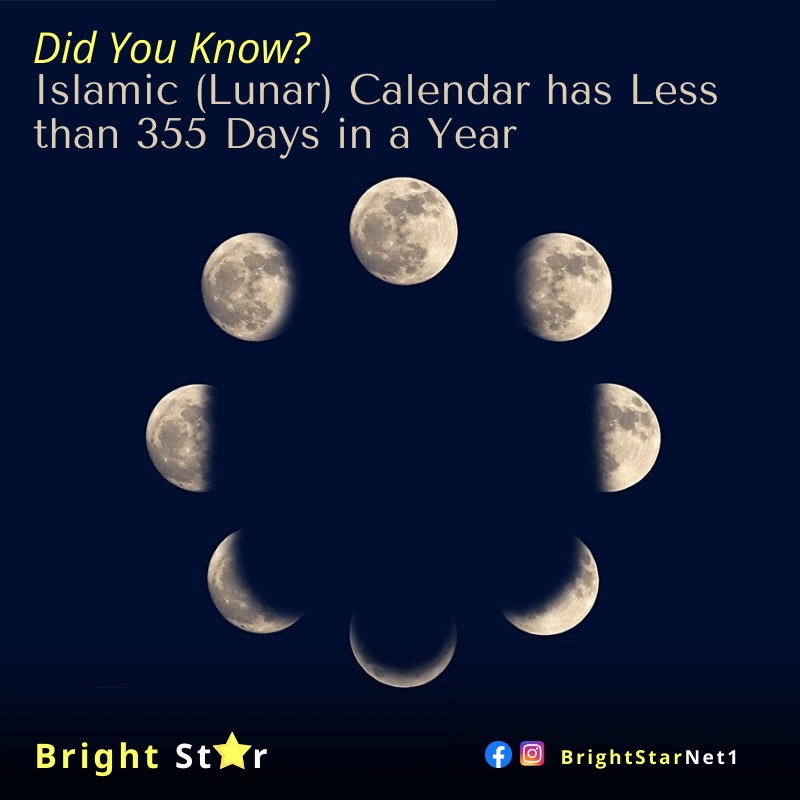The Hijri calendar, also known as the Lunar Hijri calendar and (in English) as the Islamic, Muslim or Arabic calendar, is a lunar calendar consisting of 12 lunar months in a year of 354 or 355 days.
The Hijri das and Months are used to determine the proper days of Islamic holidays and rituals, such as the annual period of fasting and the proper time for the Hajj.
The Islamic calendar employs the Hijri era whose epoch was established as the Islamic New Year of 622 CE. During that year, Muslims’ Last Prophet, Muhammad, and his followers migrated from Mecca to Medina and established the first Muslim community (ummah), an event commemorated as the Hijra.
Hijri Months their Names and Meanings
- Al-Muḥarram (ٱلْمُحَرَّم) (Meaning: forbidden), A sacred month, so called because battle and all kinds of fighting are forbidden (ḥarām) during this month. Muharram includes Ashura, the tenth day.
- Ṣafar (صَفَر) (Meaning: void), Supposedly named this because pre-Islamic Arab houses were empty this time of year while their occupants gathered food.
- Rabīʿ al-ʾAwwal (رَبِيع ٱلْأَوَّل) (meaning: the first spring), Also means to graze, because cattle were grazed during this month. Also, it is a very holy month of celebration for many Muslims, as it was the month the Prophet Muhammad was born.
- Rabīʿ ath-Thānī or Rabīʿ al-ʾĀkhir (رَبِيع ٱلثَّانِي or رَبِيع ٱلْآخِر) (meaning: the second spring or the last spring)
- Jumadā al-ʾŪlā (جُمَادَىٰ ٱلْأُولَىٰ) (meaning: the first of parched land), Often considered the pre-Islamic summer. Jumādā may also be related to a verb meaning “to freeze” and another account relates that water would freeze during this time of year.
- Jumādā ath-Thāniyah or Jumādā al-ʾĀkhirah (جُمَادَىٰ ٱلثَّانِيَة or جُمَادَىٰ ٱلْآخِرَة) (meaning: the second of parched land, the last of parched land)
- Rajab (رَجَب) (meaning: respect, honor), This is the second sacred month in which fighting is forbidden. Rajab may also be related to a verb meaning “to remove”, so called because pre-Islamic Arabs would remove the heads of their spears and refrain from fighting.
- Shaʿbān (شَعْبَان) (meaning: scattered), Marked the time of year when Arab tribes dispersed to find water. Sha‘bān may also be related to a verb meaning “to be in between two things”. Another account relates that it was called thus because the month lies between Rajab and Ramadan.
- Ramaḍān (رَمَضَان) (meaning: burning heat), Burning is related to fasting as with an empty stomach one’s worldly desire will burn. Supposedly so called because of high temperatures caused by the excessive heat of the sun. Ramaḍān is the most venerated month of the Hijri calendar. During this time, Muslims must fast from pre-dawn until sunset and should give charity to the poor and needy.
- Shawwāl (شَوَّال) (meaning: raised), Female camels would normally be in calf at this time of year and raise their tails. On the first day of this month, the Eid al-Fitr, “Festival of Breaking the Fast” begins, marking the end of fasting and the end of Ramadhan.
- Ḏū al-Qaʿdah (ذُو ٱلْقَعْدَة) (meaning: the one of truce/sitting), This is a holy month during which war is banned. People are allowed to defend themselves if attacked.
- Ḏū al-Ḥijjah (ذُو ٱلْحِجَّة) (meaning: the one of pilgrimage), During this month Muslim pilgrims from all around the world congregate at Mecca to visit the Kaaba. The Hajj is performed on the eighth, ninth, and tenth of this month. Day of Arafah takes place on the ninth of the month. Eid al-Adha, the “Festival of the Sacrifice”, begins on the tenth day and ends on the thirteenth, and this is the fourth holy month during which war is banned.
Four of the twelve Hijri months are considered sacred: Rajab (7th Hijri Month), and the three consecutive months of Dhū al-Qa’dah (11th Hijri Month), Dhu al-Ḥijjah (12th Hijri Month ) and Muḥarram (1st Hijri Month).
More from Bright Star

